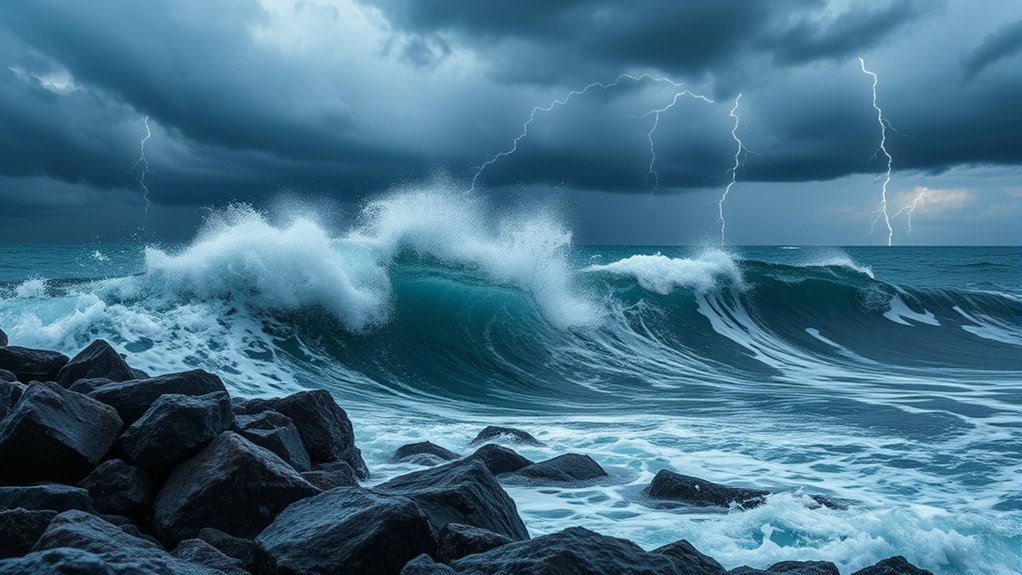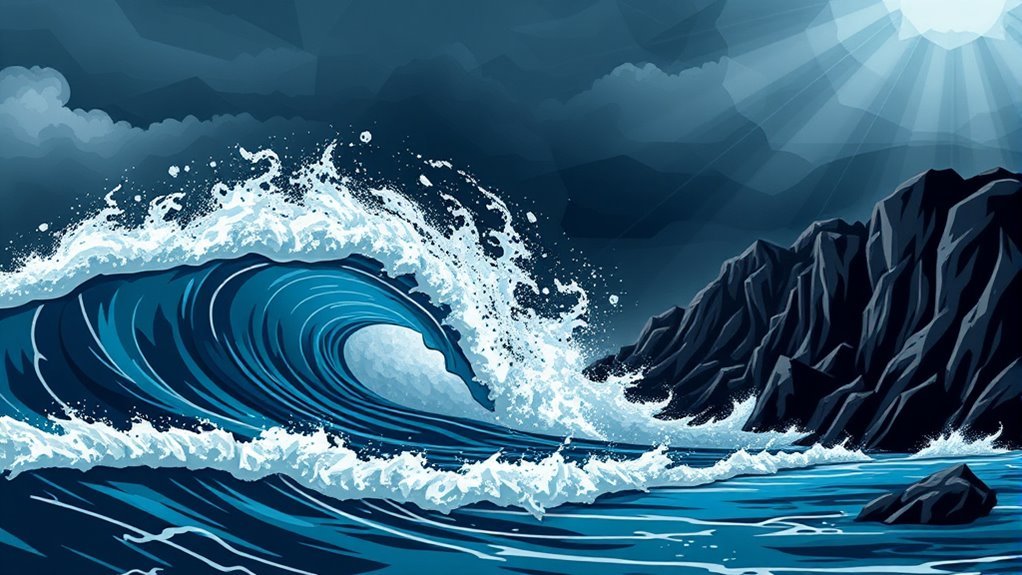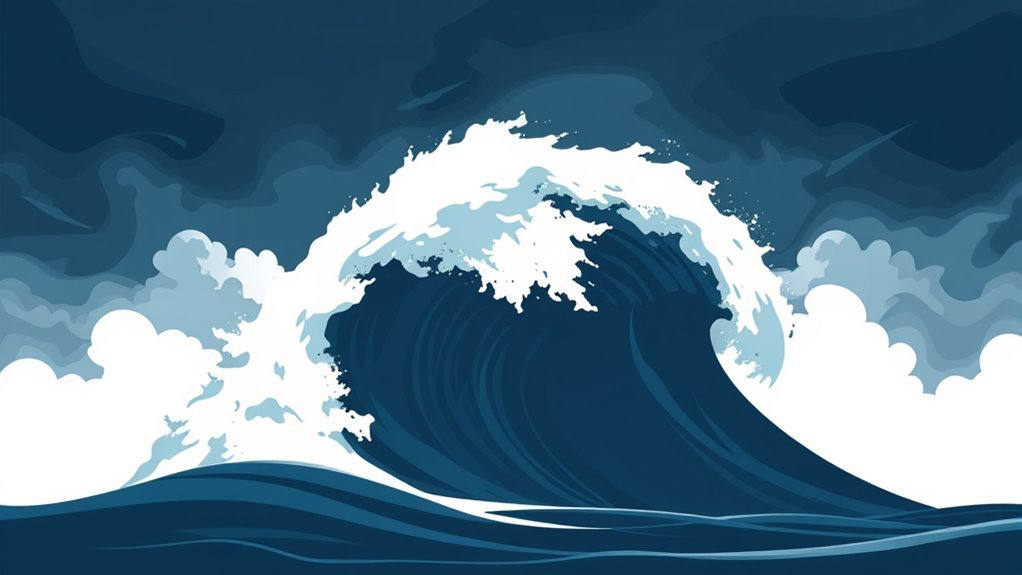Squalls greatly improve hurricane strength by rapidly increasing wind intensity and moisture levels in the storm system. These intense bursts of wind and rain raise wind speeds and contribute to the formation of new wind bands, boosting the hurricane's rotational strength. Additionally, the winds from squalls push water toward the shore, leading to increased storm surge heights. Understanding the complexities of squalls reveals deeper understandings into their impact on hurricanes and coastal flooding scenarios.
Main Points
- Squalls lead to sudden increases in wind speed, enhancing the overall wind intensity of hurricanes.
- The interaction of squalls with hurricane structures generates new wind bands, boosting the storm's rotational strength.
- Increased wind speeds from squalls push water toward the shore, significantly raising storm surge heights.
- Abrupt atmospheric pressure drops from squalls contribute to water level rises and intensified wave activity.
- Enhanced moisture from squalls fuels convection, increasing hurricane energy and potential storm surge impacts.
Understanding Squalls: Definition and Characteristics
Squalls, defined by sudden and intense bursts of wind and rain, are an essential meteorological phenomenon. These events typically occur in conjunction with thunderstorms and can manifest quickly, often catching individuals unprepared.
Marked by a rapid increase in wind speed, squalls can produce gusts that exceed 30 knots, leading to chaotic conditions. The rainfall associated with squalls is usually heavy and short-lived, resulting in reduced visibility and potential flash flooding in affected areas.
Squalls may vary in duration, usually lasting from a few minutes to several hours, depending on the atmospheric conditions. Their intensity can create notable hazards for marine and aviation activities.
Additionally, squalls can serve as precursors to larger storm systems, contributing to the complete weather dynamics in a region. Understanding their traits is critical for meteorologists and those affected by severe weather, as squalls play an essential role in the broader context of storm development.
The Formation of Hurricanes: Key Components

Hurricanes are formidable storms that require specific conditions for their formation.
Key components include warm ocean waters, which provide the necessary heat and moisture, low-pressure systems that enable air movement, and atmospheric instability that encourages cloud development.
Understanding these elements is essential for grasping how hurricanes develop and strengthen.
Warm Ocean Waters
Warm ocean waters serve as the lifeblood of hurricane formation, providing the essential heat and moisture needed for these powerful storms to develop. The temperature of the ocean surface must typically reach at least 26.5 degrees Celsius (about 80 degrees Fahrenheit) to enable the necessary evaporation.
This evaporation not only fuels the storm but also contributes to the atmospheric instability that encourages hurricane growth.
Key factors related to warm ocean waters include:
- Heat Energy: Raised temperatures provide the energy required for storm intensification.
- Moisture Supply: Increased evaporation translates to higher humidity levels, which are critical for storm dynamics.
- Depth of Warm Water: A deeper layer of warm water can sustain hurricanes longer, allowing them to grow stronger before making landfall.
Low-Pressure Systems
The presence of warm ocean waters sets the stage for the development of low-pressure systems, which are fundamental to hurricane formation.
As warm air rises from the ocean surface, it creates a void that draws in cooler, denser air from surrounding areas. This influx of air leads to a further decrease in pressure, intensifying the low-pressure system.
Over time, the system organizes, with wind patterns beginning to spiral inward, a characteristic feature of hurricanes. The interaction of moisture and heat from the ocean fuels this process, allowing the system to strengthen.
These low-pressure systems serve as the nucleus for hurricanes, establishing the necessary conditions for further development and escalation into powerful storms that can have devastating impacts.
Atmospheric Instability Factors
While several factors contribute to atmospheric instability, it is the interplay of temperature gradients, humidity levels, and wind shear that significantly influences hurricane development.
These elements create conditions conducive to the formation and intensification of hurricanes.
Key aspects include:
- Temperature Gradients: Warm ocean waters provide the necessary heat, fueling storm growth and enhancing convection.
- Humidity Levels: High humidity in the atmosphere encourages cloud formation and sustains the energy necessary for storm systems.
- Wind Shear: Variations in wind speed and direction at different altitudes can either aid or inhibit storm organization, impacting its overall strength.
Understanding these atmospheric instability factors is vital for predicting hurricane behavior and potential impacts on coastal regions, particularly regarding storm surges.
The Role of Squalls in Hurricane Development

Squalls play an essential role in the development of hurricanes by influencing the atmospheric conditions necessary for their formation.
The process of squall formation contributes to increased wind intensity, which can enhance the storm's strength.
Additionally, the rainfall and moisture provided by squalls are vital for fueling the energy needed for hurricane growth.
Squall Formation Process
Although often overlooked, the formation of squalls plays a crucial role in the development of hurricanes. These intense rain-bearing storms emerge from various meteorological conditions, contributing to the comprehensive structure and dynamics of hurricanes.
The squall formation process typically involves:
- Moisture Convergence: Warm, moist air converges at low pressure areas, creating instability.
- Cumulus Development: Rising warm air forms cumulus clouds, which can rapidly develop into squalls under the right conditions.
- Enhanced Updrafts: Strong updrafts within the squalls can lead to further organization of the storm system.
Through these processes, squalls can greatly influence the intensity and structure of hurricanes, serving as a precursor to more severe weather phenomena.
Understanding this mechanism is essential for predicting hurricane behavior and potential impacts.
Impact on Wind Intensity
As squalls develop and intensify, they greatly contribute to the wind intensity of hurricanes. These short-lived, localized wind events generate strong gusts that can improve the overall wind field of the storm.
When squalls collide with the existing hurricane structure, they can create a feedback loop, increasing the storm's wind speeds. This interaction often leads to the formation of new wind bands, which can further boost the hurricane's rotational strength.
Additionally, the upward motion associated with squalls can disrupt the balance within the storm, allowing for more potent convection.
In the end, the cumulative effect of squalls can raise wind intensity, considerably impacting the hurricane's capacity to cause damage upon landfall.
Understanding this dynamic is essential for accurate storm forecasting and risk assessment.
Rainfall and Moisture Contribution
The interplay between squalls and hurricanes extends beyond wind intensity to include rainfall and moisture dynamics. Squalls, defined by intense rainfall, play a essential role in improving the moisture content within a hurricane's environment. This added moisture can lead to several notable outcomes:
- Energy Amplification: Increased moisture fuels convection, potentially intensifying the storm's energy and strength.
- Precipitation Redistribution: Squalls can redistribute rainfall, affecting local hydrology and storm surge formation.
- Atmospheric Feedback: Improved moisture levels influence atmospheric pressure patterns, further affecting hurricane development.
Through these mechanisms, squalls contribute substantially to the comprehensive dynamics of hurricanes, reinforcing their intensity and the potential for destructive storm surges.
Understanding this relationship is critical for predicting hurricane behavior and impacts on coastal regions.
How Squalls Enhance Wind Speeds in Hurricanes

When squalls develop within a hurricane, they can greatly boost wind speeds, creating a more dangerous environment. These intense bursts of wind and rain occur when warm, moist air rises rapidly, leading to the formation of powerful thunderstorms.
As squalls merge with the hurricane's existing winds, they can amplify the total wind speed. This phenomenon is largely due to the energy exchange between the squalls and the larger cyclone structure.
Moreover, squalls can create localized areas of extreme wind, often referred to as "mini-cyclones," which contribute to the hurricane's intensity. The increased wind speeds can lead to more severe damage to structures and terrains, raising the threat to life and property.
The interaction between squalls and the hurricane's circulation not only boosts wind speeds but also plays a vital role in the hurricane's total dynamics, nurturing a more volatile atmospheric environment.
The Impact of Squalls on Storm Surge Formation

Squalls not only improve wind speeds within hurricanes but also greatly influence storm surge formation. These intense bursts of wind can markedly raise sea levels, resulting in devastating coastal flooding. The relationship between squalls and storm surges is vital for understanding the potential impact of hurricanes.
Factors contributing to this phenomenon include:
- Increased Wind Velocity: Squalls generate rapid wind speeds that push water toward the shore, boosting surge heights.
- Localized Pressure Changes: The abrupt drops in atmospheric pressure associated with squalls can cause water levels to rise unexpectedly.
- Wave Action: Improved wave activity during squalls contributes to the total water level, exacerbating the storm surge effect.
Together, these elements illustrate how squalls serve as a key component in storm surge dynamics, emphasizing the need for accurate forecasting and preparedness in hurricane-prone areas.
Understanding this interaction is essential for mitigating the risks associated with severe weather events.
Case Studies: Squalls and Notable Hurricanes
Historical hurricane events illustrate the substantial role of squalls in shaping storm intensity and impacts.
For instance, Hurricane Harvey in 2017 demonstrated how squalls can improve rainfall rates and exacerbate flooding. The squalls preceding the hurricane's landfall contributed to increased moisture, resulting in record-breaking rainfall levels, particularly in Texas.
Similarly, Hurricane Katrina in 2005 showcased the interaction between squalls and the hurricane's strength. Squalls formed ahead of Katrina, feeding the storm with additional heat and moisture, which intensified its winds and contributed to its catastrophic storm surge.
Additionally, Hurricane Maria in 2017 illustrated the rapid intensification of storms influenced by squall lines. As squalls moved ahead of Maria, they provided essential energy that led to increased wind speeds.
These case studies underscore the critical importance of understanding squalls in the context of hurricane forecasting and their consequences for coastal communities.
Preparing for the Risks: Squalls, Hurricanes, and Coastal Flooding
Understanding the relationship between squalls and hurricanes is essential for effective preparation against the risks they pose, particularly in coastal areas.
Squalls can intensify hurricane conditions, leading to increased wind speeds and storm surges that threaten coastal communities. Effective preparation measures can mitigate these risks and improve safety.
To better prepare for the impending threats, individuals and communities should consider the following strategies:
- Emergency Kits: Assemble supplies including water, non-perishable food, medications, and flashlights.
- Evacuation Plans: Establish and communicate clear evacuation routes and procedures in case of severe weather warnings.
- Community Awareness: Engage in local programs that educate residents about the risks of squalls and hurricanes, promoting a culture of preparedness.
Common Questions
How Do Squalls Differ From Regular Thunderstorms?
Squalls differ from regular thunderstorms primarily in intensity and duration. They are defined by sudden, strong winds and heavy rain that can occur quickly, often leading to severe weather conditions, unlike the more predictable patterns of regular thunderstorms.
Can Squalls Occur Outside Hurricane Seasons?
Squalls can indeed occur outside hurricane seasons. These intense bursts of wind and rain are typically associated with cold fronts and can manifest at any time, regardless of the larger seasonal weather patterns influencing tropical systems.
What Are the Warning Signs of an Approaching Squall?
The warning signs of an approaching squall include sudden drops in temperature, darkening skies, increased wind speeds, and the appearance of towering cumulus clouds. These indicators signal an imminent and often intense weather change.
How Do Squalls Affect Marine Activities and Shipping?
Squalls considerably impact marine activities and shipping by creating sudden, intense winds and rough seas. These conditions increase the risk of accidents, disrupting navigation and operations, prompting vessels to seek shelter or alter their routes.
Are Squalls Predictable Using Weather Technology?
Squalls can be predicted using advanced weather technology, including radar and satellite imagery. Meteorologists analyze atmospheric conditions to provide alerts, although their sudden nature may still challenge precise timing and location forecasts.

